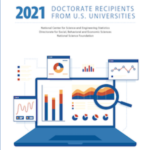 All Entries in the "Gender Gap" Category
All Entries in the "Gender Gap" Category

Women Make Up More Than Three Quarters of All Teachers in K-12 Schools
Overall, 76.6 percent of the nation’s teachers in K-12 schools are women. Women make up nearly 90 percent of all teachers in elementary schools. Women are 72.4 percent of middle school teachers and 59 percent of high school teachers.

Women to Continue to Make Progress Toward Equality at Leading Business Schools
The data shows that although overall enrollments in MBA programs are down, the number of women students increased in 2022. There are 17 leading business schools where women make up at least 45 percent of all enrollments. Leading the way are the business schools at Johns Hopkins University and the University of Pennsylvania, where women were 50 percent or more of all enrollments.

Gender Gap in Graduation Rates for Students Athletes on Scholarship
Three quarters of women students who entered college in 2013 between 2012 and 2015 with an athletic scholarship went on to earn their degree at the same educational institution within six years. Only 62 percent of men who entered college with an athletic scholarship in those years earned a bachelor’s degree by 2021 at the same institution.

Gender Differences in the Age of Doctoral Degree Recipients in the United States
In 2021, women were more likely to earn a doctorate at an older age. For example, 14.7 percent of all women who earned doctorates in 2021 were over the age of 40. For men earning doctorates in 2021, only 9.8 percent were over the age of 40.

Legislation Aims to Boost the Number of Women-Owned Firms Managing Higher Education Endowments
Women- and minority-owned asset management firms currently control only 1.4 percent of the over $82 trillion in managed assets in the United States compared to the 98.6 percent of assets controlled by firms owned by White men.

Study Finds Women Medical Students Publish Less Scholarly Research Than Their Male Peers
A new study led by Mytien Nguyen an M.D.-Ph.D. student at Yale School of Medicine found that there were only slight differences between men and women medical school students in research experiences. But women students had 10 percent fewer publications than their male peers.

The Significant Gender Gap in College Graduation Rates
The statistics show that 64.5 percent of all students entering four-year colleges in 2015 seeking a bachelor’s degree had graduated within six years. Some 66.4 percent of all women had earned a degree within six years compared to 60.4 percent of men. Women graduated at a higher rate than men in all racial and ethnic groups.

Is the Art Market Biased Against Works Created by Women?
A study led by researchers at the Yale School of Management notes that a large percentage of artworks sold at auction or displayed at major museums were created by men. But their research shows that for graduates of the Yale School of Art, the gender gap no longer exists.

Men Continue to Score Higher Than Women on the SAT College Entrance Examination
The results showed that 46 percent of men and 40 percent of women met the college and career readiness benchmark for both reading and mathematics. Men were 50 percent more likely than women to score in the 1400-1600 range, scores typically required for admission to the nation’s most selective colleges and universities.

The Large Gender Gap in Higher Education Enrollments Narrowed Slightly This Fall
A new report from the National Student Clearinghouse Research Center finds that enrollments of women in undergraduate programs this fall are down 2.1 percent, compared to a decline of 0.7 percent for men. Women’s enrollments in graduate programs are down 1.9 percent this year. For men, graduate enrollments are down 1.1 percent.

Pandemic Resulted in Significant Drop in ACT Scores But Gender Disparities Remain Constant
This year the average composite score on the ACT test for all students was 19.8. This is the lowest score since 1991. While the average scores have been declining, the small gender gap in test scores has remained relatively constant over the past decade with only minor fluctuations.

An Analysis of the Gender Gap in High School and College Graduation Rates Across the United States
A new study by scholars at the Brookings Institution finds that in every U.S. state young women are more likely than their male counterparts to have a bachelor’s degree. The education gender gap emerges well before college. Girls are more likely to graduate high school on time than boys.

United Nations Study Presents Stark Statistics on Gender Inequality Worldwide
The report finds that post-pandemic there is a diminishing outlook for gender equality. Violence against women remains high; global health, climate, and humanitarian crises have further increased risks of violence, especially for the most vulnerable women and girls.

How to Close the Gender Gap in the Cybersecurity Workforce
A joint study by Boston Consulting Group and The Global Cybersecurity Forum finds that women still only make up a quarter of the workforce in the field of cybersecurity. And the global cybersecurity workforce would need to grow by 80 percent to meet the current demand. The report outlines a number of strategies to close the gender gap and satisfy the demand for more workers in the field.

How Higher Education Contributes to Occupational Segregation by Gender in the United States
Students entering postsecondary institutions already are segregated across fields of study by gender. For example, about 6 percent of male students entering college intend to major in computer science, compared to 1 percent of women. Some 12 percent of entering male students plan to major in engineering compared to 2 percent of entering women students.

A Check-Up on the Progress of Women in Academic Radiology
In 2019, women were more than 51 percent of all students enrolling in U.S. medical schools. But women were only 27 percent of all residents in radiology. Although progress has been made, women remained vastly underrepresented in radiology faculty at U.S. medical schools.

Gender Differences in Employment and Compensation for Women in the Arts
In the 2015-19 period, women were 47.6 percent of all artists, roughly equivalent to the percentage of women in the entire labor force. But as in the economy as a whole, there are many occupations where women hold the vast majority of positions and others where the representation of women is low. Women artists (working full‐year, full‐time) earned $0.80 for every dollar earned by men artists.

New Report Examines Gender Differences in Bullying Victimization at School
More than 25 percent of all girls ages 12 to 18 in 2019 reported that they had been bullied at school compared to 19 percent of boys. The largest gender gap was in cyberbullying. More than 22 percent of all girls who were bullied said that they had been victims of cyberbullying. Only 7.6 percent of boys said they were victims of cyberbullying.

Report Finds Limited Progress in Closing the Gender Gap in Leadership Positions in K-12 Education
According to the American Superintendent 2020 Decennial Study, 26.7 percent of district superintendents across the country were women. Today in Utah, 12.2 percent (5 of 41) of superintendents are women, a number that remains unchanged since 2017. Women make up just 29 percent of all high school principals.

Study Finds That Women Do Not Receive the Credit They Deserve in Scientific Research
The results of the study showed that women who worked on a research project were 13 percent less likely to be named as authors in related scientific articles compared to their male colleagues. Furthermore, women were 59 percent less likely than men to be named on patents related to projects that they both worked on.

Study Finds a Persistent and Longstanding Gender Gap in Leadership Aspirations
A new study finds that women in the United States are still less likely than men to express a desire to take on leadership or managerial roles. The gender gap in leadership aspirations, which has remained relatively constant over six decades, translated into more than two male leaders to every one female leader at the highest levels.

Study Finds Gender Differences in Qualifications for Appointment to the Federal Bench
A new study by scholars at the University of Louisville, Yale University, and Oregon State University finds that women of color appointed to the federal judiciary typically have a greater depth of professional experiences and are more likely to have previously served as a judge than their White male counterparts.

Study of Facebook Data Examines Worldwide Gender Differences in Preferences
Research by scholars at Southern Methodist University in Dallas and Universidad Carlos III de Madrid in Spain examined how the difference in preferences between men and women changes with a country’s degree of gender equality.

The Productivity Penalty Impacting New Mothers in the Academic World
Despite strides in family-leave offerings, and men taking a greater role in parenting, women in academia still experience about a 20 percent drop in productivity after having a child, while their male counterparts generally do not, according to a new study by researchers at the University of Colorado Boulder.

The Stubborn Gender Pay Gap in Academic Medicine
A new study finds that women starting out their careers in academic medicine are paid less than men in almost all areas of medicine. The authors conclude that equalizing starting salaries would address the majority of the differences in earning potential.

Women Earn Less Than Men in All Fifty States
The gender gap was the largest in the state of Wyoming. There, women earned only 63 cents for every dollar earned by men. Vermont has the lowest gender earning gap. There, the median earnings of men were $51,241 compared to median earnings of $46,641 for women. Thus, women made 91 cents to the dollar earned by men.

How Gender Disparities in Wealth Impact Higher Education
The U.S. Census Bureau recently released new data on household wealth in 2019. The statistics show that the median net worth of households headed by single men was $50,150 in 2019. For households headed by a single woman, the median net worth was $36,600. About 80 percent of all single-parent families are headed by women.

Grading the Schools With the Largest Athletic Programs on Their Gender Diversity in Leadership Posts
The latest report on the status of women and racial and ethnic minorities in leadership positions at the 130 educational institutions in the Football Bowl Subdivision of the NCCA has been released by The Institute for Diversity and Ethics in Sport (TIDES) at the University of Central Florida. These are generally the schools with the nation’s largest athletic programs.

American Women Save Less for Retirement Than Their Male Peers
About 50 percent of women ages 55 to 66 have no personal retirement savings, compared to 47 percent of men. Women also lag men in the amount of retirement savings. Some 22 percent of women have $100,000 or more in personal retirement savings compared to 30 percent of men.

Women Are a Small Percentage of Finance Faculty But Some Slow Progress Is Being Made
A new study conducted by Mila G. Sherman, professor of finance in the Isenberg School of Management at the University of Massachusetts Amherst, and Heather Tookes, professor of finance at the Yale School of Management, finds that only 16 percent of the finance faculty at the nation’s top business schools are women.

The Extent of Gender and Racial Bias in Academic Research
A new study of more than 5 million articles published between 2008 and 2019 — primarily by U.S.-based researchers found that Black, Latino, and women authors are underrepresented in many STEM fields and often appear as authors only in less-cited fields.

New Reports Examines the Impact of a Women College or University President on the Gender Pay Gap in Academia
A new report from CUPA-HR finds that female senior institutional officers, institutional administrators, and heads of divisions are paid more equitably at institutions with a female president than at institutions with a male president.

Women Still Vastly Underrepresented Among Presidents of the Nation’s Leading Research Universities
A new report from the Women’s Power Gap Initiative at the Eos Foundation, in partnership with the American Association of University Women, finds that women make up only 22 percent of the presidents at the nation’s major research universities. Most striking is the fact that 60 of these 130 research universities have never had a woman president.

Disgusted by a Professor’s Remarks, Boise State University Senior Raises Funds for Women in STEM
After a faculty member stated that “making special efforts to recruit women into fields where they don’t seem to want to be” should cease, Ally Orr, a senior at Boise State, responded with a GoFundMe campaign that raised $70,000 for the Women in STEM, Medicine and Law Scholarship. The scholarship will help fund the education of women in these fields at Boise State this fall.

In Workers Compensation Cases, Women Win More Money When Their Doctors Are Women
A new study from economics researchers at the University of Texas at Austin and the University of Illinois at Chicago showed that female claimants were 5 percent more likely to be evaluated as disabled and received about 8.5 percent more in cash benefits when the doctor assigned to their claim was female rather than male. There was no difference for male patients.








